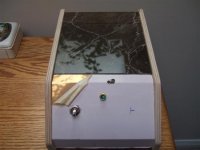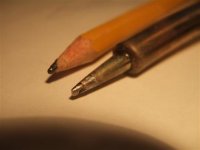U. The UA has better DC specs, but they shouldn't affect it much. We have tested with both and didn't note a difference. The PGA2311 is the PA version, however (higher end).
dynamic headroom
Brian,
I would like to commend you on this project. You have done a fine job. I especially like your
PCB layout.
I am curious as to why you chose the PGA2311 over the PGA2310 or PGA2320 counterparts?
These devices are pin for pin compatible, and it appears that they could share the same
controller (coding). The main difference being that the 2310 and 2320's operate on +/- 15V
rails, which offers MUCH better dynamic headroom, capable of 27V. swing.
Best regards,
David
http://focus.ti.com/docs/prod/folders/print/pga2310.html
Brian,
I would like to commend you on this project. You have done a fine job. I especially like your
PCB layout.
I am curious as to why you chose the PGA2311 over the PGA2310 or PGA2320 counterparts?
These devices are pin for pin compatible, and it appears that they could share the same
controller (coding). The main difference being that the 2310 and 2320's operate on +/- 15V
rails, which offers MUCH better dynamic headroom, capable of 27V. swing.
Best regards,
David
http://focus.ti.com/docs/prod/folders/print/pga2310.html
Hi David,
Thanks for the compliments, Brian did (and always does) a fabulous job with the kits and helping me test/develop the circuit, but the design/layout is my work. 🙂
I chose the PGA2311 for a very simple reason, lower THD and better all around specs. 🙂 And since I have a buffer on the output with 12V rails the higher rail voltage of the 2310/2320 were of little importance to me, in fact if you ask the right people at TI you will find out the the higher volatge parts are really compromise parts so people do not have to add their own VRs to layout. More important are the audio specs where the PGA2311 has a clear advantage.
The myth of higher voltage always = better audio performance is one that seems to be well established, but it is certainly not true here. 🙂
Cheers!
Russ
Thanks for the compliments, Brian did (and always does) a fabulous job with the kits and helping me test/develop the circuit, but the design/layout is my work. 🙂
I chose the PGA2311 for a very simple reason, lower THD and better all around specs. 🙂 And since I have a buffer on the output with 12V rails the higher rail voltage of the 2310/2320 were of little importance to me, in fact if you ask the right people at TI you will find out the the higher volatge parts are really compromise parts so people do not have to add their own VRs to layout. More important are the audio specs where the PGA2311 has a clear advantage.
The myth of higher voltage always = better audio performance is one that seems to be well established, but it is certainly not true here. 🙂
Cheers!
Russ
Russ White said:The myth of higher voltage always = better audio performance is one that seems to be well established, but it is certainly not true here. 🙂
Russ
It is certainly true in other audio applications, however, that higher V+- benefits opamp performance.
Take a look at manufacturer's datasheets from TI, Analog, Linear Tech etc.and you'll find that open-loop bandwidth is better for higher supply voltages, as is comon mode rejection and slew rate.
TI has a particular axe to grind in low voltage and single-supply opamps for cell-phone and portable operations.
It ain't a myth.
The myth is that it is "always" better, for "all" applications. And no, some opamps do NOT work better at higher voltage, though some(maybe even most) clearly do.
I was not saying that there are not applications where higher voltage rails for opamps are better. 🙂 In fact if you look at the circuit you can see I believe the opposite. Look at the rails for the input and output buffers. I use a good value for the preferred opamp in the circuit, the AD8620 which is +/-12V. 🙂 I could have used +/-5V.
I was not saying that there are not applications where higher voltage rails for opamps are better. 🙂 In fact if you look at the circuit you can see I believe the opposite. Look at the rails for the input and output buffers. I use a good value for the preferred opamp in the circuit, the AD8620 which is +/-12V. 🙂 I could have used +/-5V.
preamp case
good morning Russ,Brian
I plan to pre build the preamp case. This time I may use some arborite and perhaps 1/8"bronze plate-if I can cut it with my table saw or router.
As far as source selection, I was planning to use a rotary switch. Not very high tech. but I am trying to keep costs down. Any comments to using a rotary switch for source selection? my inputs will be 4, turntable, cd for now; and 2 extra.
cheers
doggy
good morning Russ,Brian
I plan to pre build the preamp case. This time I may use some arborite and perhaps 1/8"bronze plate-if I can cut it with my table saw or router.
As far as source selection, I was planning to use a rotary switch. Not very high tech. but I am trying to keep costs down. Any comments to using a rotary switch for source selection? my inputs will be 4, turntable, cd for now; and 2 extra.
cheers
doggy

I assume a rotary switch for a source selector would work just fine. A bit neanderthal, but it would work.
I have another question; could I build a passive riaa circuit for records and use this preamp via a source switch for the amplification ? instead of building a stand alone phono preamp? The cartridge input would be mm; not mc.
cheers
doggy
p.s. just got the 1st snow today
I have another question; could I build a passive riaa circuit for records and use this preamp via a source switch for the amplification ? instead of building a stand alone phono preamp? The cartridge input would be mm; not mc.
cheers
doggy

p.s. just got the 1st snow today
Attachments
Hi doggy,
You might want to look at Rod Elliott's site under the preamp section. He's laid out out how to wire up a rotary switch as a source selector rather nicely.
Not sure if linking to someone else's site is frowned upon so...
http://sound.westhost.com
regards
Dave
p.s. Just trying to place where you are. I'm thinking Delta/Surrey?
You might want to look at Rod Elliott's site under the preamp section. He's laid out out how to wire up a rotary switch as a source selector rather nicely.
Not sure if linking to someone else's site is frowned upon so...
http://sound.westhost.com
regards
Dave
p.s. Just trying to place where you are. I'm thinking Delta/Surrey?
hi phoneisbusy,
Surrey, just up the scott road hill; that's the putullo bridge in the background. Am working on the preamp case today. Thanks for the link.
cheers
doggy
Surrey, just up the scott road hill; that's the putullo bridge in the background. Am working on the preamp case today. Thanks for the link.
cheers
doggy

progress so far:
Chassis is wood; sides and back are left-over baltic birch [note plys]. Front is 1/8" bronze; top is marble tile-had a good time cutting with a wet saw; it wanted to chip! Will finish with nitro. lacquer[it drys fast].Front face has led, on-off toggle switch and volume control when the kit arrives. My source selector will be mounted at the back; close to the rca's.
cheers,
doggy
Chassis is wood; sides and back are left-over baltic birch [note plys]. Front is 1/8" bronze; top is marble tile-had a good time cutting with a wet saw; it wanted to chip! Will finish with nitro. lacquer[it drys fast].Front face has led, on-off toggle switch and volume control when the kit arrives. My source selector will be mounted at the back; close to the rca's.
cheers,
doggy

Attachments
Thats a great case man! 🙂 Good work, thats going to be a sweet pre. 
I really like the marble! Nice touch. Can't wait to see the finished project. 😀
Cheers!
Russ

I really like the marble! Nice touch. Can't wait to see the finished project. 😀
Cheers!

Russ
Yes Doggy, that start's to look very nice indeed.
The source selector you are reffering to, is that the one from Twisted Pair Audio 😉
Cheers
The source selector you are reffering to, is that the one from Twisted Pair Audio 😉
Cheers
Unfortunately that SS is not in production yet, I think Doggy is going to use a rotory switch, which should work quite well really.
Cheers!
Russ
Cheers!
Russ
I know Russ, couldn't resist to post a small joke. 
I'm looking forward to the SS when it's finished.
Cheers

I'm looking forward to the SS when it's finished.
Cheers
So, I was thinking of offering to pre-mount the SOIC opamps, if anyone wanted it. I know they can be troublesome, but I've gotten very good at it. Just a thought...
BrianDonegan said:So, I was thinking of offering to pre-mount the SOIC opamps, if anyone wanted it. I know they can be troublesome, but I've gotten very good at it. Just a thought...
I finished mine but we're still running in the Rev_C @ Reputes house.
Once I get it back I will tell you how my slder job went... (poof) 🙂
good morning all;
It would be nice to have a picture gallery; I would like to see what other members have built; including Brian and Russ.
The Hako 936 soldering station cost about $120. but it is very good. Heat up is very fast, about 30 sec. and the tip is really durable. My last 40 watt iron, the copper tip eroded with use. Also the hako 907 iron is slim and able to get in tight spots
cheers;
doggy
It would be nice to have a picture gallery; I would like to see what other members have built; including Brian and Russ.
The Hako 936 soldering station cost about $120. but it is very good. Heat up is very fast, about 30 sec. and the tip is really durable. My last 40 watt iron, the copper tip eroded with use. Also the hako 907 iron is slim and able to get in tight spots
cheers;
doggy

Attachments
there are actually smaller HAKO tips -- HMW carries them. If working with SMT it's always helpful to have some thin copper braid to clean up mistakes.
BrianDonegan said:Added another option for PCB + Preprogrammed PIC at $15.
Hi Brian and Russ,
Will you guys sell just the programmed PICs?
I bought a couple of old and not working Adcom GFA1 200WPC stereo amps on ebay. I want to strip them of the old pcb and I am designing a new PCB for them. It is the rev 3 Mauro MyRef3886 design with the OP227/PGA2311 in front. The amps are 25 years old and have a massive heavy toroid transformer. I don't know the VA but it will be overkill.
 Unfortunatly the rectifiers put out +/- 45VDC so I will have to regulate the supplies down to +/- 37V.
Unfortunatly the rectifiers put out +/- 45VDC so I will have to regulate the supplies down to +/- 37V.Schematic is done but I am still working on the layout.
What pot are you guys using?
- Status
- Not open for further replies.
- Home
- Amplifiers
- Headphone Systems
- Digitally controlled preamp/headphone amp


